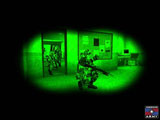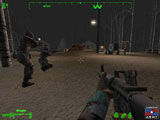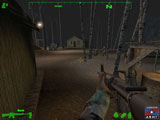 You can tell a lot about a culture
from the games it plays. Most societies’ games represent a demonstration of skill in
some useful task—19th and early 20th century homesteaders often
competed to see who could best wield an axe, or shoot a gun, or make a warm blanket. These
games both helped homesteaders stay sharp with certain necessary skills and allowed them
to compare their skill to their neighbors’. This is where things begin to get sticky
for video game fans. From the outside, today’s video games look like they’re
helping players maintain deadly skills like shooting people or running over them. The
violence in video games is their most hotly debated attribute, constantly asking a
perfectly reasonable question: What do our games prepare us for? To be productive hunters
and woodcutters, or sociopaths and mass murderers?
You can tell a lot about a culture
from the games it plays. Most societies’ games represent a demonstration of skill in
some useful task—19th and early 20th century homesteaders often
competed to see who could best wield an axe, or shoot a gun, or make a warm blanket. These
games both helped homesteaders stay sharp with certain necessary skills and allowed them
to compare their skill to their neighbors’. This is where things begin to get sticky
for video game fans. From the outside, today’s video games look like they’re
helping players maintain deadly skills like shooting people or running over them. The
violence in video games is their most hotly debated attribute, constantly asking a
perfectly reasonable question: What do our games prepare us for? To be productive hunters
and woodcutters, or sociopaths and mass murderers? Obviously, most gamers would say the
former before the latter. Gamers know that Max Payne is no more preparing them for a life
of vigilanteism than Mario Sunshine is preparing them for a life of cleaning island
resorts. Games have become a way of blowing off steam, a means of escape like movies or
television—all media that has been criticized by politicians for promoting violent
behavior. However, the violence debate is about to get complicated with the release of the
US Army’s new game. Now, the U.S. armed forces have long attracted recruits by
endowing service with a sense of adventure, offering young men and women the opportunity
to tour the world, meet exciting new civilizations, sneak behind enemy lines, and help
neutralize the threat. Meanwhile, video games have grown steadily more war-like, sometimes
consulting the Pentagon on matters of realism in weapons and enemy behavior. It was only a
matter of time, then, for the Pentagon to commission a video game of its own.
America’s Army was created and developed by the army, and has begun billing itself as
"The official U.S. Army game." Although developers stop short of admitting this
game is intended to shore up flagging enlistment numbers and give civilians a taste of
real Army training, there are a few indications that America’s Army is and does just
that.
Obviously, most gamers would say the
former before the latter. Gamers know that Max Payne is no more preparing them for a life
of vigilanteism than Mario Sunshine is preparing them for a life of cleaning island
resorts. Games have become a way of blowing off steam, a means of escape like movies or
television—all media that has been criticized by politicians for promoting violent
behavior. However, the violence debate is about to get complicated with the release of the
US Army’s new game. Now, the U.S. armed forces have long attracted recruits by
endowing service with a sense of adventure, offering young men and women the opportunity
to tour the world, meet exciting new civilizations, sneak behind enemy lines, and help
neutralize the threat. Meanwhile, video games have grown steadily more war-like, sometimes
consulting the Pentagon on matters of realism in weapons and enemy behavior. It was only a
matter of time, then, for the Pentagon to commission a video game of its own.
America’s Army was created and developed by the army, and has begun billing itself as
"The official U.S. Army game." Although developers stop short of admitting this
game is intended to shore up flagging enlistment numbers and give civilians a taste of
real Army training, there are a few indications that America’s Army is and does just
that.
 America’s
Army is actually two games in one. There’s Soldiers, a single-player 2D RPG in which
you guide a soldier from enlistee to high ranking officer, periodically tweaking the
character’s values and goals to shape the soldier’s final outcome. You’ll
help your soldier settle upon a career, get an education, visit the recruiter, and advance
through the ranks, all while "progress[ing] through the Army and see[ing] for
yourself what a rich life experience the U.S. Army offers." The game will play like
an interactive movie, as its Story Engine software drives a Movie Generation System, which
assembles and plays video and audio based upon your input. The game holds and espouses
values central to the Army: loyalty, duty, respect, selfless service, honor, integrity,
and personal courage. Your job is to coordinate six resources and input the decisions that
reflect the Army’s values. Resources are health, strength, knowledge, skills,
finances, and popularity. You win if your soldier becomes a Sergeant.
America’s
Army is actually two games in one. There’s Soldiers, a single-player 2D RPG in which
you guide a soldier from enlistee to high ranking officer, periodically tweaking the
character’s values and goals to shape the soldier’s final outcome. You’ll
help your soldier settle upon a career, get an education, visit the recruiter, and advance
through the ranks, all while "progress[ing] through the Army and see[ing] for
yourself what a rich life experience the U.S. Army offers." The game will play like
an interactive movie, as its Story Engine software drives a Movie Generation System, which
assembles and plays video and audio based upon your input. The game holds and espouses
values central to the Army: loyalty, duty, respect, selfless service, honor, integrity,
and personal courage. Your job is to coordinate six resources and input the decisions that
reflect the Army’s values. Resources are health, strength, knowledge, skills,
finances, and popularity. You win if your soldier becomes a Sergeant.
 The second
game in America’s Army will definitely attract the most attention. It’s an FPS
based on the Unreal Warfare engine. Squad-based multi-player missions will comprise the
bulk of game play, though there will be solo training missions. Multiple environments like
indoor, swamp, desert, and forest will add variety, while soldier BDU’s (battle dress
uniforms) will update for fuller realism. In an interesting pro-America twist, no matter
what squad you play on, your teammates will appear to you as the US Army, while your
opponents appear as the enemy. In one mission, for example, you’re a group of elite
Army soldiers sneaking into a terrorist camp to retrieve important intelligence from their
computers. Or you’re a group of elite Army soldiers protecting sensitive government
intelligence from an invading band of terrorists.
The second
game in America’s Army will definitely attract the most attention. It’s an FPS
based on the Unreal Warfare engine. Squad-based multi-player missions will comprise the
bulk of game play, though there will be solo training missions. Multiple environments like
indoor, swamp, desert, and forest will add variety, while soldier BDU’s (battle dress
uniforms) will update for fuller realism. In an interesting pro-America twist, no matter
what squad you play on, your teammates will appear to you as the US Army, while your
opponents appear as the enemy. In one mission, for example, you’re a group of elite
Army soldiers sneaking into a terrorist camp to retrieve important intelligence from their
computers. Or you’re a group of elite Army soldiers protecting sensitive government
intelligence from an invading band of terrorists.
 Since
America’s Army has the virtue of being designed by the US Army, it will command the
most realistic portrayal of weapons and combat of any game. Game designers were taken on
simulated missions, and each development was approved for accuracy and realism. Weapon
reload times are true to life, as is the potential for weapon jamming. Grenades have a
more realistic explosion radius of up to 250 feet, necessitating strong teamwork to avoid
incidents of friendly fire. Communications are handled via whisper modes or animated hand
signals, for which the squad leader has unique commands. The US Army’s Rules of
Engagement are enforced to the letter. Shoot your teammates or kill innocent civilians and
you’ll land your soldier in prison. Multiple violations will put a black mark beside
your name, making it difficult to be accepted into the online servers. The abiding
emphasis in this game is on teamwork, and that alone distinguishes it from other
FPS’s on the market. Its tactical emphasis will also appeal to fans of Rogue Spear
and other squad-based military games. In other words, this is a solid game that should be
hotly anticipated by fans of the genre and military buffs alike.
Since
America’s Army has the virtue of being designed by the US Army, it will command the
most realistic portrayal of weapons and combat of any game. Game designers were taken on
simulated missions, and each development was approved for accuracy and realism. Weapon
reload times are true to life, as is the potential for weapon jamming. Grenades have a
more realistic explosion radius of up to 250 feet, necessitating strong teamwork to avoid
incidents of friendly fire. Communications are handled via whisper modes or animated hand
signals, for which the squad leader has unique commands. The US Army’s Rules of
Engagement are enforced to the letter. Shoot your teammates or kill innocent civilians and
you’ll land your soldier in prison. Multiple violations will put a black mark beside
your name, making it difficult to be accepted into the online servers. The abiding
emphasis in this game is on teamwork, and that alone distinguishes it from other
FPS’s on the market. Its tactical emphasis will also appeal to fans of Rogue Spear
and other squad-based military games. In other words, this is a solid game that should be
hotly anticipated by fans of the genre and military buffs alike.
 But where
does America’s Army fit in its broader context? It’s not, after all, a
traditional video game. It will be distributed for free via internet in July, with CDs
coming in August bundled in hardware or gaming magazines. It’s not merely a one-time
recruiting tool, either— there will be continuous support in the form of more
missions and tours of duty. The Pentagon sees America’s Army as a communications tool
instead of a recruiting tool; the game will collect no data on its players, and requires
no commitment to the armed forces to play. However, its emphasis on teamwork
notwithstanding, America’s Army is still a first-person-shooter, a game just as
deserving of a violent reputation as the now infamous Doom in post-Columbine America. The
debate about video game violence can never be the same following the release of
America’s Army, for how will politicians condemn violent digital gun battles when
their own government has sponsored, designed, and freely distributed just such a game?
But where
does America’s Army fit in its broader context? It’s not, after all, a
traditional video game. It will be distributed for free via internet in July, with CDs
coming in August bundled in hardware or gaming magazines. It’s not merely a one-time
recruiting tool, either— there will be continuous support in the form of more
missions and tours of duty. The Pentagon sees America’s Army as a communications tool
instead of a recruiting tool; the game will collect no data on its players, and requires
no commitment to the armed forces to play. However, its emphasis on teamwork
notwithstanding, America’s Army is still a first-person-shooter, a game just as
deserving of a violent reputation as the now infamous Doom in post-Columbine America. The
debate about video game violence can never be the same following the release of
America’s Army, for how will politicians condemn violent digital gun battles when
their own government has sponsored, designed, and freely distributed just such a game?
